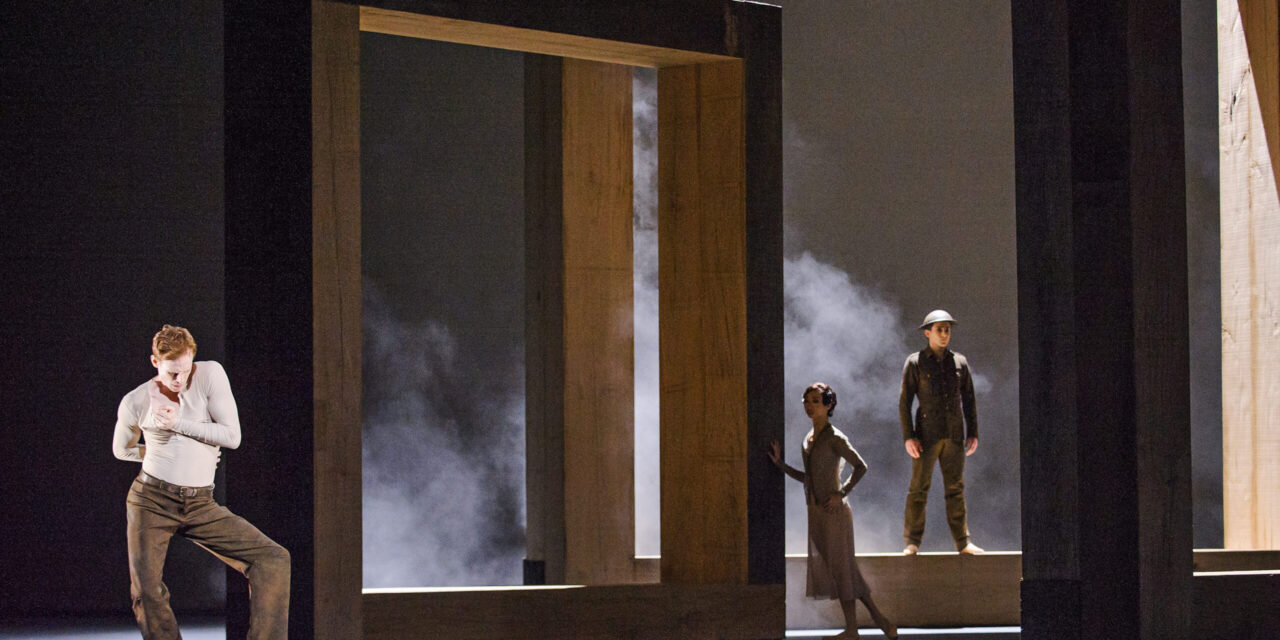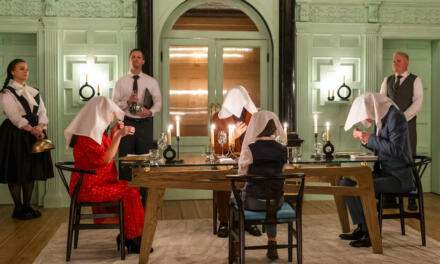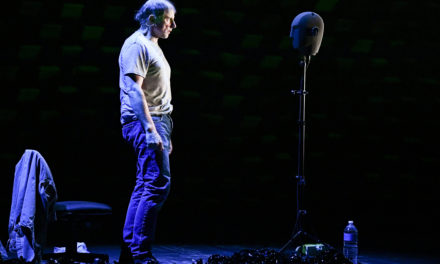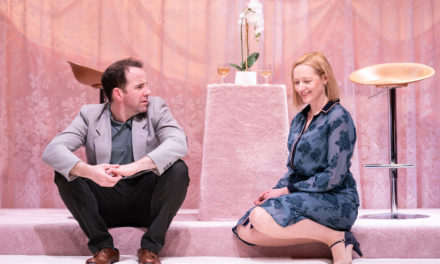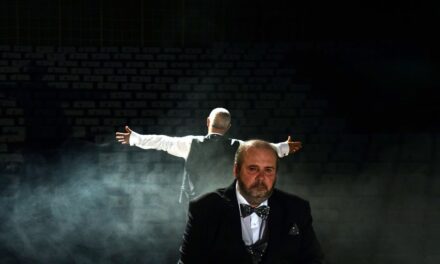Rute Costa in conversation with Uzma Hameed, dance dramaturg of Woolf Works
It was December 2019 when I sat down with dramaturg Uzma Hameed in a Covent Garden cafe. We talked about her work in theatre and dance, the interplay of text and movement in dance dramaturgy, and the process of putting Virginia Woolf on the Royal Opera House stage.
Woolf Works is Wayne McGregor’s ballet triptych, inspired by the writings of Virginia Woolf and has an original score by Max Richter. It was created for The Royal Ballet in 2015 and met with outstanding critical acclaim, going on to win McGregor the Critics’ Circle Award for Best Classical Choreography and the Olivier Award for Best New Dance Production. It was reprised in 2017.
Rute Costa: You work in different roles: writer, dramaturg, and director. In your work with your own ensemble, The Big Picture Company, you combined various mediums like dance, music, theatre, and film. What was your process like? How did you go about scripting movement?
Uzma Hameed: When you’re working that way, you end up refining different methods as you go along, depending on the production. One of the productions we did was called A Dark River (1999), a British-Asian play based on Lorca’s Blood Wedding. I wrote a script for that – it was possibly a good way to go because the starting point was a play that already exists. I was really struck in that case by the synergies between Arabic and Spanish culture, and the musical intersection between Flamenco and Kathak (I was trained as a Kathak dancer). The text was interspersed with extracts from the Lorca play as the protagonist had flashback sequences. These were the places where we brought in the dance and the music.
We had an original score written by Paul Clark, an amazing composer, and he interwove bits of the Lorca poetry in both languages with the music. So, you’d have bits of the Spanish overlaid with the English translation – whispers in her head and nightmares she was having. We would use the choreography to create those inner emotional states, when she was remembering something or to set up a counterpoint between reality and dream world. I asked a Rachel Harris, a colleague of mine who was a founding member of the company and trained in classical Indian dance to make the movement for it. I indicated movement in the text as: “At this point there will be a choreographic sequence on the following themes…” It didn’t seem at the time to be an issue to notate the choreography because we had video recordings of it, and also I was open to it being redone, reinterpreted. We did that show for quite a few years and I’d do rewrites and the whole piece was constantly evolving, so for us it made sense.
RC: How does this translate to dance? How does text figure differently in your process of making dance from words/text?
UH: The conversation between the choreographer and me is the crucible. Although it may be that other collaborators are also drawn into our conversations about the text. When we did Woolf Works with Wayne [McGregor], we had a meeting at the beginning with Ciguë, the artists who designed the set for Act I. We talked about themes, about how we could look at these different Woolf novels through the lens of different types of literary realism. For Wayne’s most recent work, Inferno (part of The Dante Project, which is set to hit the Royal Opera House stage in 2021), I didn’t have that in advance conversation with the designer, Tacita Dean.
So, this can vary completely on every production, but the constant element is that I (as the dramaturg) and the choreographer would have a lot of discussion about the text. My role is to help them to excavate the text to access it from a thematic and structural point of view, to release it from the story. With someone like Wayne that’s relatively easy, because he thinks like that anyway. Sometimes, I’ve said, ‘Let’s just put some ideas down on post-it notes that we put on a big sheet of paper for each act.’ – that’s what happened with Woolf Works.
These notes could be themes, relationships, story, narrative fragment, a character, a quote or a design idea, or even an idea for marketing, we just stick these all down on those big sheets, and then Wayne takes them away.
When Wayne comes into the studio there’s this amazing alchemy because he just starts making movement. He is not always thinking, ‘I’m making this scene where…’ or ‘I’m making this idea that we wrote down on a post-it note’, he’s just making a duet, or a trio, or he’s just making some movement, inspired by the process of writing the notes. Later on, Wayne might put these into a duet or he’ll say, ‘Actually I could make that into a trio if you think that’s better’. But because we’ve had these really in-depth, immersive conversations about the text, the story is in there.
So, when I’m watching the movement in the rehearsal room, I’m immediately drawing connections between the texts and the characters. Then later we need to tweak and shape, and decide which sections we want to keep, which section might be suggesting something particular and if we want it to emphasize that or make it clearer or if we want to go in another direction with it.
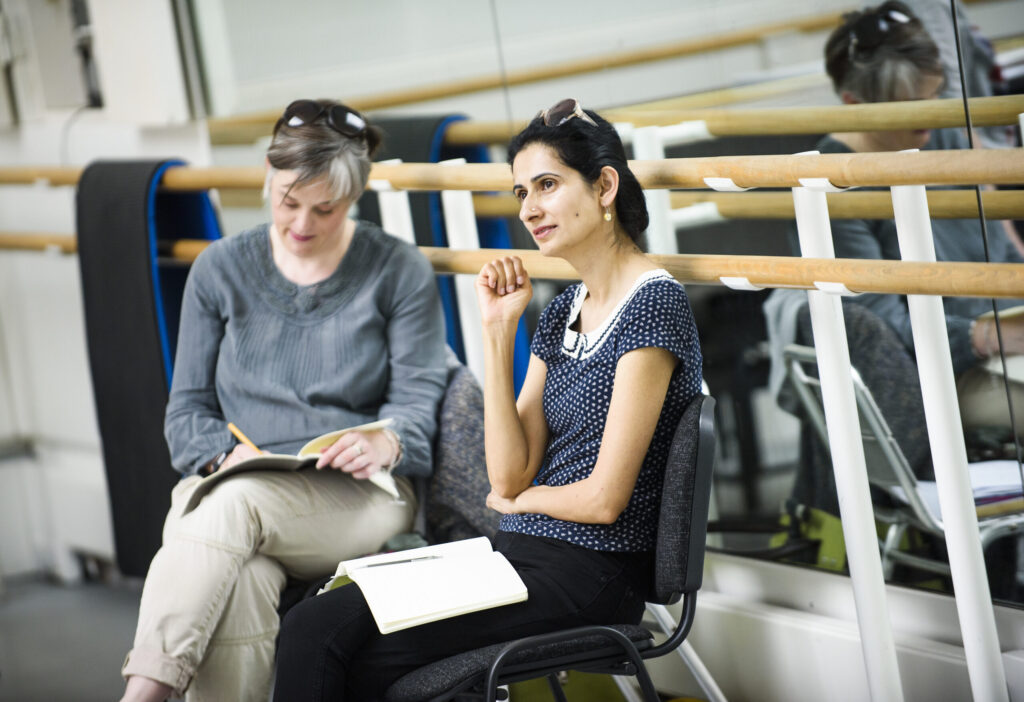
Rehearsing Woolf Works ©ROH, 2015. Photography by Tristram Kenton.
RC: Wayne McGregor says you often come into the rehearsal room and see those parallels between text and physicality. When working with text in dance, is it more of a feedback conversation between the media, than a text comes first or movement comes first kind of approach?
UH: Yes, although people think sometimes that we take the text into the rehearsal room, and I read a bit, and then the choreographer makes the movement – it doesn’t work like that. Some of the things I give the creatives are visual. For example, Wayne asked me to do a visual ‘smorgasbord’ for the whole Woolf Works. I found some images that to me suggested lines of Woolf such as ‘life is like a luminous halo’, and created some captions alongside these images, and he might take one of those into the rehearsal room and make work from it.
RC: What is it about Woolf’s prose that makes it amenable to be translated, transmediated, transposed, and turned into performance? Is it because Woolf was so influenced by other art forms that these mediums already have a life in her work?
UH: That’s exactly right. A lot of people think we picked Woolf because she writes about dance, she liked dance, and she went to see the ballet. That isn’t why we did it, but it is why Woolf’s texts speak to ballet and, specifically, to Wayne’s work because he works so much across disciplines. Another thing he’s known for, apart from playing with the tension between narrative and abstraction, is his collaboration with other artists, and working with science, cosmology, technology – everything. In the way that Woolf was incredibly curious, Wayne is incredibly curious – he’s very much a person of his time in the way that Woolf was interested in everything that was happening in her time. He’s very interested in the collaborators having a creative authority within the production – he’s not comfortable with the idea of having one theatrical interpretation and every element of the production falling under it. He’d much rather have, in design for example, an artist who will make the work that they want to make, even if it might not suit the dance particularly, (or may cause us unforeseen problems during technical rehearsals!). But that design work has an authority and therefore you may sacrifice something, perhaps, ease of movement or physical negotiation around the set. What is important is that the overall picture of it and how it dialogues with the dance has an impact of its own.
RC: You speak, particularly in the context of Woolf Works, about movement as an expression of an essence and inner states, and how movement and dance are great at ‘lifting these out of the text’ and embodying them. I wonder whether looking at literary devices or the physical language that Woolf uses also feeds into the process of creating and making movement?
UH: It’s about literary devices as well. So, I created a document about literary devices for the collaborators. That is very much part of the creative process, because that deconstructionist approach really speaks to Wayne, as much as the story, and he needs to get under the skin of the text. He’ll often say that dance is about space, body, and time. So, in a way, with each production, you need to address how the literature can speak to those three things and inhabit those zones.
RC: Do you ever worry that the connections with the text may get lost to the audience, and, if so, how do you address that as a dramaturg?
UH: There’s a whole conversation that always happens between me and Wayne about the program notes. Wayne’s work comes from such a rich seedbed, there are so many ways into the research. When we’re doing Woolf, we’re not just reading Woolf, we might be reading about space science alongside it, and the other collaborators are bringing things that resonate with the work too. So, when I write program notes, I write them in order that if the spectator wishes to have more of an insight into some of the ideas that informed the work, then they can be found in the program. We are sometimes asked if the program notes are there to describe what’s happening on stage and from my and Wayne’s point of view it isn’t that at all. We really want the audience to experience the work as a viewer in an open way. But I think it’s helpful to offer an insight if people want to find out more. Dance is an ephemeral art, isn’t it? Especially at the Opera House, the majority of the audience won’t be able to afford seeing it more than once. I wish dance could be revisited and seen, like you would read a book. It’s not as if once you know the story, you’ve seen the dance. It’s actually about a complex experience that delivers and delivers and delivers because it’s much more poetic and thematic and abstract.
RC: With pantomime and classical ballet, there’s the idea of a gestural language that means something specific. Jacques Lecoq believes there is a sort of ‘universal poetic language’ of movement, which is perhaps more abstract, but still does suggest that there is a general meaning that goes across movement and is understood by everyone. Do you think there is a poetic universal language of movement?
UH: Probably there is. But I think because it’s poetic and universal, we maybe don’t need to talk about it in advance. I think that is part of the conversation that Wayne and I are having in the studio when one of the dancers, for example, Ed does something and I might say: ‘Oh that looks like the bit where…’, you know? Because he is inhabiting to me a state that says something. So that conversation about how we are reading the work as the audience, I think the collective language comes into that.
RC: You mentioned Edward Watson. How did he develop the character of Septimus? Does the dancer read Woolf’s text for this work, or is it very much through the movement and through working with you and the choreographer that a character is sculpted?
UH: Wayne is quite keen that the dancers don’t get lots of notes early on about character because, for him, that puts them in a frame of mind where they’re trying to express, trying to play a role. Of course, they can read it if they wish, but we don’t have discussions in the rehearsal room about it for quite a while. And then, usually towards the end, there’s a moment where Wayne turns to me: ‘Can you go talk to the cast about what we’ve been doing?’. That’s always a really lovely moment for me because then I have all of them in a room together, and there’s the realization of the amount that they have embodied and not actually connected to what it means – and that is amazing. Performance clarity always goes up a level, because they’ve done all the really important internal and physical work, and then suddenly you say ‘this is a bit of a story that you’re telling us’. They just need a tiny, tiny bit of information to really transform things.
RC: Have you got any last bits of advice to other choreographers and makers who may be working with text generally, or Woolf in particular?
UH: You don’t have to do it all: you just do the thing that speaks to you, you try and work out why it speaks to you, and why that makes it interesting to put on stage. That’s how Woolf approaches art anyway. She’s not peddling a sort of falsely ordered reality, she is asking you to live a collage-y moment by moment experiential form of reality. And that’s what makes it live, if you know why you’re inside it and why it’s ringing bells for you.
(London, 2019)
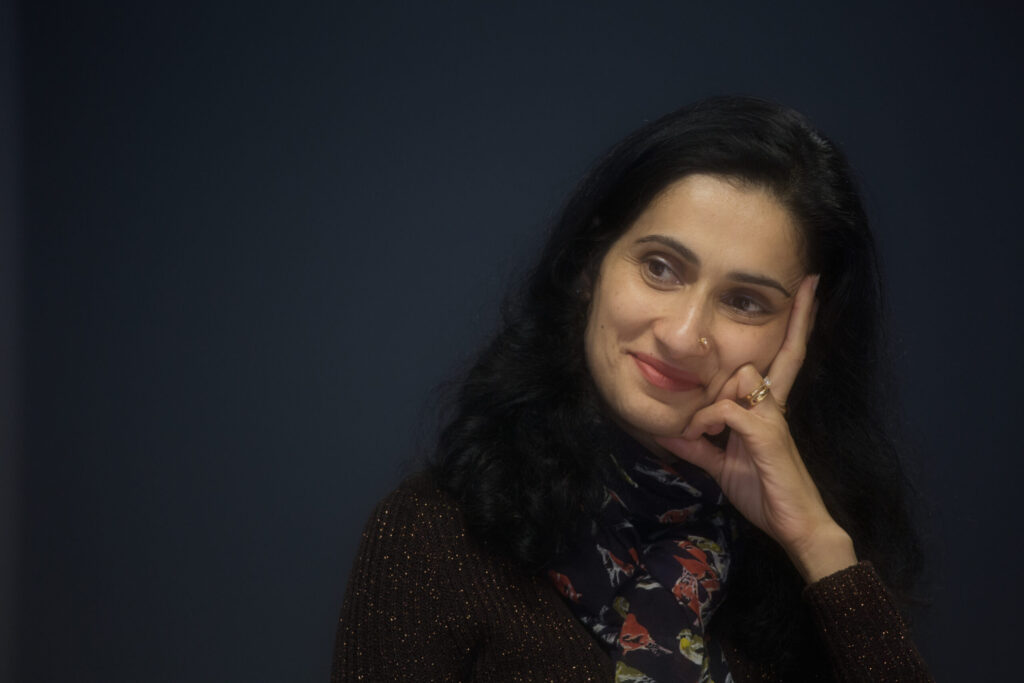
Uzma Hameed. Photo courtesy of Ravi Deepres.
Uzma Hameed is a British writer and director who made her Royal Ballet debut in 2015 as dramaturg for Wayne McGregor’s Woolf Works, and has since been the dramaturg for McGregor’s ballets Obsidian Tear and Multiverse. She has also worked as dramaturg on McGregor’s Autobiography for Company Wayne McGregor and Cathy Marston’s Victoria for Northern Ballet.
In 1997 she founded the Big Picture Company, an innovative theatre company combining new writing with choreography and film (credits include A Dark River, Taj, and Prophetess). Hameed was Associate Director at Derby Playhouse 2002–5, has directed for Kali Theatre, led projects at the National Theatre Studio, and taught on workshops and courses for a variety of organizations.
As a writer, Hameed’s current projects include the novel Undying (co-written with her sister Ambreen) and an English translation of Siegfried Lenz’s Time of the Innocents. Her reviews have appeared in such journals as Dance Theatre Journal, Dance Now, East, Animated, and The Big Issue.
Rute Costa is a Portuguese-born, London-based writer, theatre-maker and activist. She is a recent graduate of the MFA in Advanced Theatre Practice at the Royal Central School of Speech and Drama, where her thesis investigated the space for co-authorship between written and embodied texts in transmedial adaptation. Rute is a founding member of theatre company dangerously loose, whose first show ALL YOU NEED IS LOVE? (Camden People’s Theatre, 2019) explored the intersection of love and the climate crisis. Previous work as a writer and director includes e x i l e (The SpaceTriplex, Edinburgh Fringe Festival, 2017) and Yearwalk (ADC Theatre, Cambridge, 2015).
This post was written by the author in their personal capacity.The opinions expressed in this article are the author’s own and do not reflect the view of The Theatre Times, their staff or collaborators.
This post was written by Rute Costa.
The views expressed here belong to the author and do not necessarily reflect our views and opinions.

